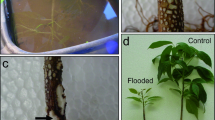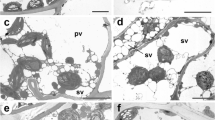Abstract
Both the poikilochlorophyllous resurrection grass, Eragrostisnindensis, and the desiccation sensitive species, E.curvula, dehydrate to a relative water content (RWC) of less than5% in two weeks. On rewatering, most E. nindensisleaves (except the older, outer ones) rehydrate and resume normal metabolicactivity within a few days, whereas E. curvula does notrecover. There is a controlled loss of photosynthetic pigments, paralleled witha gradual shutdown in gas exchange during dehydration of E.nindensis. On rehydration respiration resumes almost immediately butphotosynthesis only restarts at 70% RWC by which time chlorophyll hasbeen resynthesised and anthocyanin content reduced. In contrast, photosyntheticactivity in E. curvula is maintained down to 40%RWC, after which further drying results in a sudden breakdown of thephotosynthetic system and its pigments. At this point, electrolyte leakage andincreases FV/FM decreases such that belowca. 40% RWC, metabolism is irreparably damaged.Interestingly, the older outer leaf in most tillers of E.nindensis does not rehydrate. These leaves show signs of membranedamage and curl in an irregular manner similar to those of E.curvula during dehydration.
Similar content being viewed by others
References
Bewley J.D. and Krochko J.E. 1982. Desiccation tolerance. In: Lange O.L., Nobel P.S., Osmond C.B. and Ziegler H. (eds), Physiological Plant Ecology II. Water and carbon assimilation. Encyclopedia of Plant Physiology N.S., Springer-Verlag, Berlin, pp. 325–378.
Dace H., Sherwin H.W., Illing N. and Farrant J.M. 1998. Use of metabolic inhibitors to elucidate mechanisms of recovery from desiccation stress in the resurrection plant Xerophyta humilis. Plant Growth Regul 24: 171–177.
Dalla Vecchia F.D., Asmar T.E., Calamassi R., Rascio N. and Vazzana C. 1998. Morphological and ultrastructural aspects of dehydration and rehydration in leaves of Sporobolus stapfianus. Plant Growth Regul 24: 219–228.
Ellis R.P. 1980. Photosynthetic pathways and the geographical distribution of grasses in South West Africa/Nambia. S Afr J Sci 76: 307–314.
Farrant J.M. 2000. A comparison of mechanisms of desiccation tolerance among three angiosperm resurrection plant species. Plant Ecol (in press).
Farrant J.M., Cooper K., Kruger L.A. and Sherwin H.W. 1999. The effect of drying rate on the survival of three desiccation-tolerant angiosperm species. Ann Bot 84: 371–379.
Farrant J.M., Pammenter N.W., Berjak P. and Walters C. 1997. Subcellular organization and metabolic activity during the development of seeds that attain different levels of desiccation tolerance. Seed Sci Res 7: 135–144.
Farrant J.M. and Sherwin H.W. 1998. Mechanisms of desiccation tolerance in seeds and resurrection plants. In: Taylor A.G. and Huang X.-L. (eds), Progress in seed research: Proceedings of the second international conference on seed science and technology. Communication Services of the New York State Agricultural Experiment Station, Geneva, pp. 109–120.
Gaff D.F. 1977. Desiccation tolerant vascular plants of Southern Africa. Oecologia 31: 95–109.
Gaff D.F. 1989. Responses of desiccation tolerant “resurrection” plants to water stress. In: Kreeb K.H., Richer H. and Hickley T.M. (eds), Structural and functional responses to environmental stresses: water shortage. SPB Academic Publishing, The Hague, pp. 255–268.
Gaff D.F. and Ellis R.P. 1974. Southern African grasses with foliage that revives after dehydration. Bothalia 11: 305–308.
Ghasempour H.R., Anderson E.M., Gianello R.D. and Gaff D.F. 1998a. Growth inhibitor effects on protoplamic drought tolerance and protein synthesis in leaf cells of the resurrection grass, Sporobolus stapfianus. Plant Growth Regul 24: 179–183.
Ghasempour H.R., Gaff D.F., Williams R.P.W. and Gianello R.D. 1998b. Contents of sugars in leaves of drying desiccation tolerant flowering plants, particularly grasses. Plant Growth Regul 24: 185–191.
Gibbs Russel G.E., Watson L., Smook L., Barker N.P., Anderson H.M. and Dallwitz, M.J. 1990. Grasses of Southern Africa. In: Memoirs of the botanical survey of South Africa No. 58. National Botanical Gardens, Botanical Research Institute, Cape Town.
Gutierrez M., Gracen V.E. and Edwards G.E. 1974. Biochemical and cytological relationships in C4 plants. Planta 119: 279–300.
Kuang J., Gaff D.F., Gianello R., Blomstedt R., Neale A.D. and Hamil J.D. 1995. Changes in in vivo protein complements in drying leaves of the desiccation-tolerant grass Sporobolus stap-fianus and the desiccation-sensitive grass Sporobolus pyramidalis. Aust J Plant Physiol 22: 1027–1034.
Lichtenthaler H. 1987. Chlorophylls and carotenoids, the pigments of the photosynthetic biomembranes. Methods Enzymol 148: 350–382.
Mancinelli A.L., Yang C.-P.H., Lindquist P., Anderson O.R. and Rabino I. 1975. Photocontrol of anthocyanin synthesis III The action of streptomycin on the synthesis of chlorophyll and anthocyanin. Plant Physiol 55: 251–257.
Pammenter N.W. and Berjak P. 1999. A review of recalcitrant seed physiology in relation to desiccation-tolerance mechanisms. Seed Sci Res 9: 13–37.
Prendergast H.D.V. and Hattersley P.W. 1987. Australian C4 grasses (Poaceae): leaf blade anatomical features in relation to C4 acid decarboxylation types. Aust J Bot 35: 355–382.
Puliga S., Vazzana C. and Davies W.J. 1996. Control of crops leaf growth by chemical and hydraulic influences. J Exp Bot 47: 529–537.
Quartacci M.F., Forli M., Rascio N., Dalla Vecchia F., Bochicchio A. and Navari-Izzo F. 1997. Desiccation-tolerant Sporobolus stapfianus: lipid composition and cellular ultrastructure during dehydration and rehydration. J Exp Bot 48: 1269–1279.
Sherwin H.W. and Farrant J.M. 1996. Differences in rehydration of three desiccation-tolerant angiosperm species. Ann Bot 78: 703–710.
Sherwin H.W. and Farrant 1998. Protection mechanisms against excess light in the resurrection plants Craterostigma wilmsii and Xerophyta viscosa. Plant Growth Regul 24: 203–210.
Sutaryono Y.A. and Gaff D.F. 1992. Grazing potential of desiccation tolerant tropical and subtropical grasses. Trans Mal Soc Plant Physiol 3: 180–183.
Tuba Z., Protor M.C.F. and Csintalan Z. 1998. Ecophysiological responses of homoiochlorophyllous and poikilochlorophyllous desiccation tolerant plants: a comparison and an ecological perspective. Plant Growth Regul 24: 211–217.
Vertucci C.W. and Farrant J.M. 1995. Acquisition and loss of desiccation tolerance. In: Kiegel J. and Galili G. (eds), Seed development and germination. Marcel Dekker Inc., New York, pp. 237–271.
von Caemmerer S. and Farquhar G.D. 1981. Some relationships between the biochemistry of photosynthesis and the gas exchange of leaves. Planta 153: 376–387.
Author information
Authors and Affiliations
Rights and permissions
About this article
Cite this article
Vander Willigen, C., Pammenter, N., Mundree, S. et al. Some physiological comparisons between the resurrection grass, Eragrostis nindensis, and the related desiccation-sensitive species, E. curvula . Plant Growth Regulation 35, 121–129 (2001). https://doi.org/10.1023/A:1014425619913
Issue Date:
DOI: https://doi.org/10.1023/A:1014425619913




